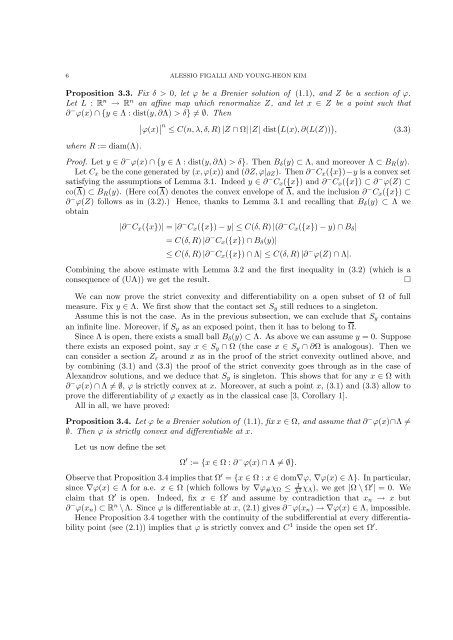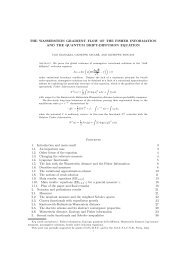Partial regularity of Brenier solutions of the Monge-Ampère equation
Partial regularity of Brenier solutions of the Monge-Ampère equation
Partial regularity of Brenier solutions of the Monge-Ampère equation
You also want an ePaper? Increase the reach of your titles
YUMPU automatically turns print PDFs into web optimized ePapers that Google loves.
6 ALESSIO FIGALLI AND YOUNG-HEON KIM<br />
Proposition 3.3. Fix δ > 0, let ϕ be a <strong>Brenier</strong> solution <strong>of</strong> (1.1), and Z be a section <strong>of</strong> ϕ.<br />
Let L : R n → R n an affine map which renormalize Z, and let x ∈ Z be a point such that<br />
∂ − ϕ(x) ∩ {y ∈ Λ : dist(y, ∂Λ) > δ} = ∅. Then<br />
<br />
ϕ(x) n ≤ C(n, λ, δ, R) |Z ∩ Ω| |Z| dist ( L(x), ∂(L(Z)) ) , (3.3)<br />
where R := diam(Λ).<br />
Pro<strong>of</strong>. Let y ∈ ∂ − ϕ(x) ∩ {y ∈ Λ : dist(y, ∂Λ) > δ}. Then Bδ(y) ⊂ Λ, and moreover Λ ⊂ BR(y).<br />
Let Cx be <strong>the</strong> cone generated by (x, ϕ(x)) and (∂Z, ϕ|∂Z). Then ∂ − Cx({x})−y is a convex set<br />
satisfying <strong>the</strong> assumptions <strong>of</strong> Lemma 3.1. Indeed y ∈ ∂ − Cx({x}) and ∂ − Cx({x}) ⊂ ∂ − ϕ(Z) ⊂<br />
co(Λ) ⊂ BR(y). (Here co(Λ) denotes <strong>the</strong> convex envelope <strong>of</strong> Λ, and <strong>the</strong> inclusion ∂ − Cx({x}) ⊂<br />
∂ − ϕ(Z) follows as in (3.2).) Hence, thanks to Lemma 3.1 and recalling that Bδ(y) ⊂ Λ we<br />
obtain<br />
|∂ − Cx({x})| = |∂ − Cx({x}) − y| ≤ C(δ, R) |(∂ − Cx({x}) − y) ∩ Bδ|<br />
= C(δ, R) |∂ − Cx({x}) ∩ Bδ(y)|<br />
≤ C(δ, R) |∂ − Cx({x}) ∩ Λ| ≤ C(δ, R) |∂ − ϕ(Z) ∩ Λ|.<br />
Combining <strong>the</strong> above estimate with Lemma 3.2 and <strong>the</strong> first inequality in (3.2) (which is a<br />
consequence <strong>of</strong> (UA)) we get <strong>the</strong> result. <br />
We can now prove <strong>the</strong> strict convexity and differentiability on a open subset <strong>of</strong> Ω <strong>of</strong> full<br />
measure. Fix y ∈ Λ. We first show that <strong>the</strong> contact set Sy still reduces to a singleton.<br />
Assume this is not <strong>the</strong> case. As in <strong>the</strong> previous subsection, we can exclude that Sy contains<br />
an infinite line. Moreover, if Sy as an exposed point, <strong>the</strong>n it has to belong to Ω.<br />
Since Λ is open, <strong>the</strong>re exists a small ball Bδ(y) ⊂ Λ. As above we can assume y = 0. Suppose<br />
<strong>the</strong>re exists an exposed point, say x ∈ Sy ∩ Ω (<strong>the</strong> case x ∈ Sy ∩ ∂Ω is analogous). Then we<br />
can consider a section Zε around x as in <strong>the</strong> pro<strong>of</strong> <strong>of</strong> <strong>the</strong> strict convexity outlined above, and<br />
by combining (3.1) and (3.3) <strong>the</strong> pro<strong>of</strong> <strong>of</strong> <strong>the</strong> strict convexity goes through as in <strong>the</strong> case <strong>of</strong><br />
Alexandrov <strong>solutions</strong>, and we deduce that Sy is singleton. This shows that for any x ∈ Ω with<br />
∂ − ϕ(x) ∩ Λ = ∅, ϕ is strictly convex at x. Moreover, at such a point x, (3.1) and (3.3) allow to<br />
prove <strong>the</strong> differentiability <strong>of</strong> ϕ exactly as in <strong>the</strong> classical case [3, Corollary 1].<br />
All in all, we have proved:<br />
Proposition 3.4. Let ϕ be a <strong>Brenier</strong> solution <strong>of</strong> (1.1), fix x ∈ Ω, and assume that ∂ − ϕ(x)∩Λ =<br />
∅. Then ϕ is strictly convex and differentiable at x.<br />
Let us now define <strong>the</strong> set<br />
Ω ′ := {x ∈ Ω : ∂ − ϕ(x) ∩ Λ = ∅}.<br />
Observe that Proposition 3.4 implies that Ω ′ = {x ∈ Ω : x ∈ dom∇ϕ, ∇ϕ(x) ∈ Λ}. In particular,<br />
since ∇ϕ(x) ∈ Λ for a.e. x ∈ Ω (which follows by ∇ϕ#χΩ ≤ 1<br />
λ2 χΛ), we get |Ω \ Ω ′ | = 0. We<br />
claim that Ω ′ is open. Indeed, fix x ∈ Ω ′ and assume by contradiction that xn → x but<br />
∂−ϕ(xn) ⊂ Rn \ Λ. Since ϕ is differentiable at x, (2.1) gives ∂−ϕ(xn) → ∇ϕ(x) ∈ Λ, impossible.<br />
Hence Proposition 3.4 toge<strong>the</strong>r with <strong>the</strong> continuity <strong>of</strong> <strong>the</strong> subdifferential at every differentiability<br />
point (see (2.1)) implies that ϕ is strictly convex and C1 inside <strong>the</strong> open set Ω ′ .



